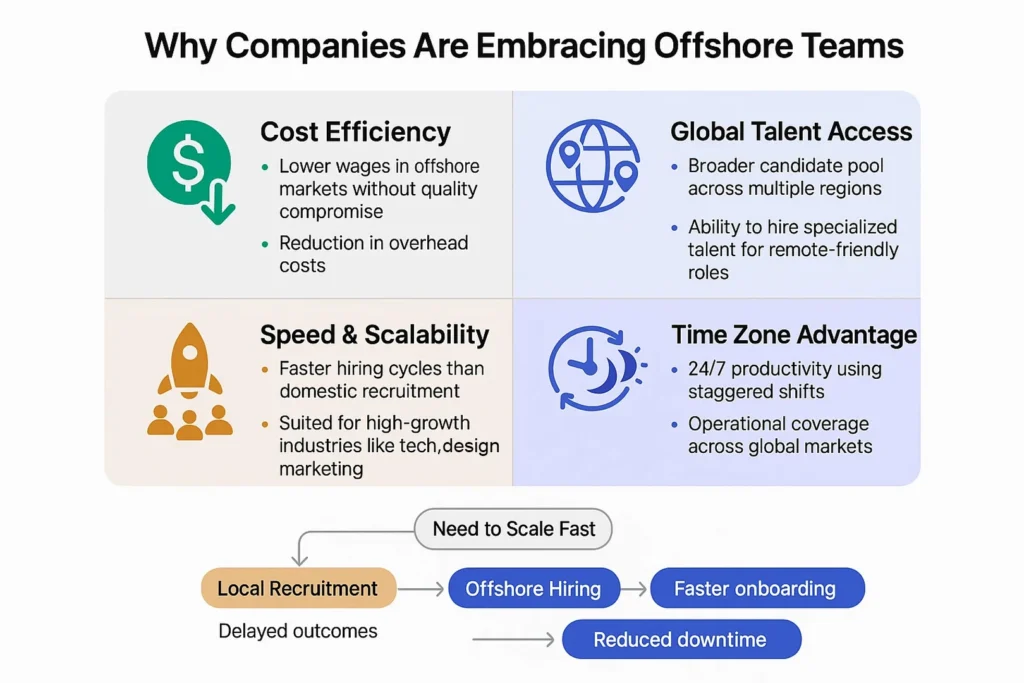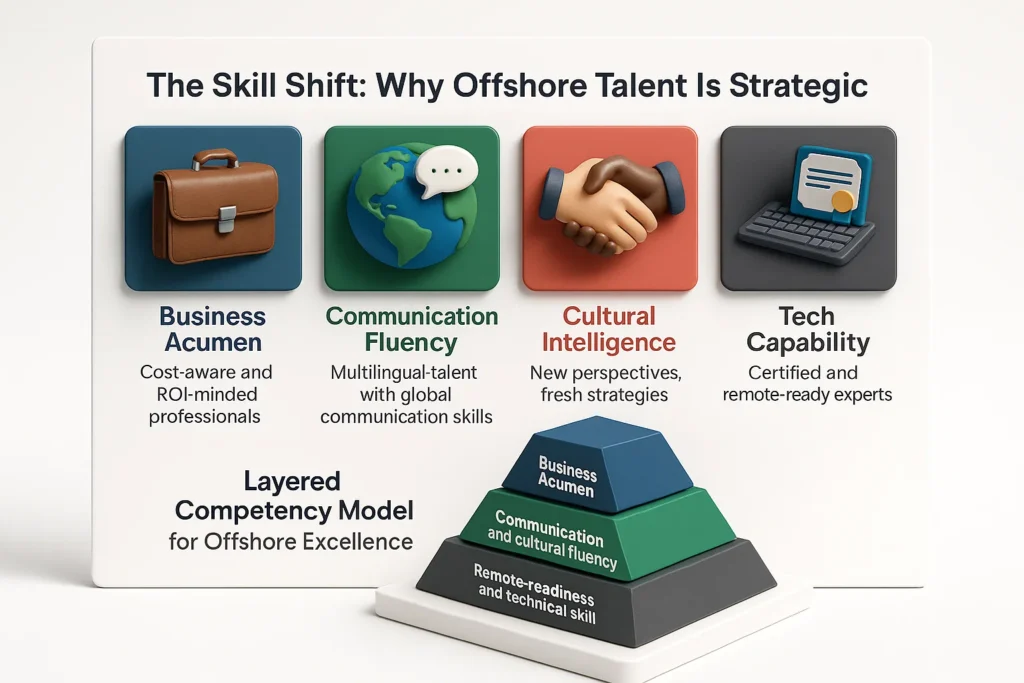The Ultimate Guide for Businesses in the Global Economy
Remote work has changed drastically over the last few months from being a short-term solution to life under a pandemic into something that’s here to stay as part of the global workforce. As companies adjust to the new normal, the trend also involves not only remote work, but what’s described as the rise of “remote-friendly” roles — those where you can work remotely mixed with in-office, or even hybrid models. This change is removing geographic boundaries, allowing businesses and talent bodies to outgrow their local environs. In this borderless work revolution, the implications are significant — offshore, they are reshaping the way companies hire, and how they do business.
The COVID-19 pandemic prompted numerous businesses to rapidly switch to remote working, but what initially appeared to be a short-term need has now become the new normal for the contemporary workforce. There are many upsides to remote work such as cost savings, higher employee satisfaction and being able to tap into a larger talent pool. And as companies started to see these advantages, multiple proved adopting remote work during the pandemic was no longer a temporary necessity, but a strategic path for business growth. This has seen a focus on remote-friendly jobs, meaning work can be done from anywhere: a home office, a co-working space (which companies usually pay for) or from a café.
Though remote work can be flexible, not all positions or companies are ready for a “remote-only” model. Many companies strive to accommodate the lifestyle of the modern worker with their business model and have adopted a “remote-friendly” policy. That may mean some roles are capable of allowing employees to work part-time or certain days of the week from home, but still call for in-office presence for collaboration purposes, meetings, or team building efforts. “Remote-friendly models are an hybrid solution that represent the best from both worlds by providing the flexibility we all crave while ensuring that in-person interactions are there for collaboration and company culture.”

Remote work has been shaped by shifting attitudes among both employers and workers. At first, working from home was a stopgap — a panicky expedition in panic time. But it soon became clear that working from home could actually boost productivity and employee satisfaction. As corporate attitudes changed, they began to view flexibility as a competitive advantage. Remote work wasn’t a crisis response, but rather a strategic lever to attract talent, lower overhead costs and grow into new markets. Employers which had previously been wary of remote workforce models have implemented hybrid or remote-first plans, aware that flexibility in work location can be better for the employer and employee.
Hybrid vs. Remote-First: Where Companies Stand Today
The argument over hybrid work versus a remote-first model continues to play out, with, of course, companies taking varying strides. Hybrid model: One in which employees can work both remotely and in an office, depending on the nature of their work and a company’s requirements. This model is versatile yet there is a physical office space. On the other side of things, are remote-first companies, which have fully adopted the belief that employees can work from wherever and have structured their workflows, communication, and culture around this. The move to remote-first is frequently backed by companies seeking to tap into global talent and cut office expenses. Yet both models can be implemented successfully, and the decision for one or the other depends on the particular corporate culture, goals, and the types of roles they have to offer.
The most fundamental change introduced by remote is now recruiting talent is no longer bound by geography. In the traditional sense, businesses were (in effect) limited to sourcing talent that was local or, if they were lucky, regional. Remote work has changed the game, breaking the constraints of borders and enabling companies to source top talent worldwide. This pool of worldwide talent represents an abundance of expertise, experience and various viewpoints that companies are just scratching the surface of when it comes to learning from and advancing with them. The growing utility of borderless job descriptions is evidence of this change where companies are no longer being forced to hire closer to home.
Hiring for Roles, Not Regions
With more remote work, companies are hiring for jobs, not geography. This approach looks to determine the best-fit candidate by their skill set and experience, not by distance to the office. The idea of hiring for job titles instead of locations pushes companies to broaden their scope of hires and the availability of talent. With this same level of quality and performance, companies can now resource and hire in regions where the cost of labor is less. Employees could also work in positions that they wouldn’t have had access to based strictly on geographical location.

And there are a few reasons why companies are increasingly warming to the idea of offshore teams, particularly when remote-friendly roles are becoming more typical. One of the most common incentives is cost efficiency. Companies are leveraging offshore talent to cut costs without sacrificing quality. You will find that in many countries you can find extremely talented labour at a fraction of the cost of what you can expect to find in developed markets. Offshore teams also allow you to scale faster as they are able to pull from a global network of workers and fill roles faster. Moreover, companies can leverage time zone differences by working around the clock, supporting 24/7 operations and making it so work never sleeps.
Global Recruitment at Speed and Scale
Offshore teams provide the ability to scale quickly for companies. Startup that needs a team to grow quickly or an enterprise that has several positions to fill, with offshore hiring organizations can find the candidates they need faster than if they depend on local jobseekers only. Rolling talent searches benefits businesses by expanding the talent pool beyond the confines of the local job market, thus reducing downtime in finding and hiring qualified candidates. Rapid scaling is particularly crucial in industries that experience swift innovation or near-constant updates, like tech, marketing and design.

Some jobs lend themselves particularly well to remote work and have experienced a wave of offshoring. These are tech and development positions, in which developers, engineers, and IT staff can often work remotely and conduct business virtually. Marketing, design, and creative services are also doing well in remote settings, with digital marketers, graphic artists, and copywriters frequently working from home or co-working spaces. Moreover, customer service, virtual assistants and admin jobs have grown more remote-friendly, enabling companies to provide round the clock customer service by working with offshore hires from various time zones. If the even more niche professions like accounting and lawyers have taken to it, it’s possible for anyone in the sector to work from a wide range of places and still be effective and in compliance.

The offshore team worries about: Why should offshoring teams understand business drivers like overhead costs, resource man hours, and investment returns accordingly. Fluency in a foreign language and excellent communication skills are frequently distinct advantages, as organisations with offshore teams are more able to service foreign customers. There is also a major advantage of cross-cultural collaboration, with offshoring providing new perspectives and new angles of attack. A lot of offshore experts also come with technical certifications and background in remote work, so they’re very well suited for digital work and virtual collaboration.
The increasingly popular offshore model is a great opportunity for a business, but job displacement to local job markets is a concern for many. If firms are poaching workers from abroad, that could be bad news for their local counterparts. But it also offers potential for to upskill and reskill local talent. When businesses pivot with growing globalization of the job force, workers will need to be more capable to cultivate skills which meet the standards for working offsite and working from abroad. The local-vs.-global talent conundrum will force businesses and governments to strike a balance, between both the advantages of offshoring hires, and the necessity to support and invest in local workforces.
There are numerous legal and compliance concerns to keep in mind when hiring offshore talent. Businesses have to deal with intricacies of tax laws, labor laws, and IP laws in different countries. The risks of misclassification, for example whether a worker offshore is an employee or a contractor, are a source of legal headache. Many are mitigating some of this risk by using Employer of Record (EOR) services or global HR platforms that can handle payroll, compliance, and other legal requirements on the employer’s behalf.
One of the common worries when dealing with offshore teams is the company culture. When your employees are spread across countries and time zones, it can be tough to cultivate a feeling of belonging and team spirit. But the right approach can help organizations establish a vibrant culture despite a distributed workforce. All through, regular communication, virtual team-building activities and clarity of expectations are key in keeping teams engaged and motivated. Businesses can develop a unified culture that goes beyond geographical lines by embracing diversity and sharing values.
Leading an offshore team requires a different approach and change in leadership behaviour. Clearly setting expectations, laying out KPIs, communicating in an open and transparent way are critical to the success of a remote work team. Trust-building is crucial, given that remote working is based on autonomy and accountability of employees. They should also provide leadership training for how to manage teams across cultures and time zones and make sure that managers have the tools to support and lead offshore workers.
Although offshore team’s benefits are myriad, there are also some down sides to it. Communication lags and time-zone friction can cause misunderstandings and inefficiency. However, data security and the necessary architecture remains an important consideration if you are using an offshore talent, particularly when confidential data is at its heart. Resistance from those who have legacy management behavior with brick and mortar office environment can also be a barrier to the integration of remote teams.
For companies to properly manage their offshore teams, they require the tools that help them to effectively communicate and collaborate, and manage the projects. Apps like Slack, Trello, Asana and Monday. com can keep teams organized and on track. Video conferencing technology like Zoom and Microsoft Teams allow for instant communication, meanwhile, digital infrastructure, cloud services and automation tools help break down silos and keep work moving across borders.
With remote work and offshore hiring being the new reality, companies will have to prepare for the future of remote-offshore collaboration. The Next Wave of Globalization: Disruption of Geography Now it is about disrupting geography and having a truly global workforce without borders. Getting ready for a world without hiring borders will require businesses to re-imagine traditional talent strategies, and invest in tools, systems, and training to support the management of a distributed team.
The ascendance of remote-friendly jobs has led to a reimagining of how companies think about hiring and operations. At such times as we are able to recruit from offshore workers and global pools of expertise, we can now access the best global of the best. Through a combination of flexibility, adoption of the correct tools and a clear steer through the legal and compliance minefield, this new, borderless way of working is workable. The word work in the future is literally without walls, and the talent is unlimited.
There is, in the end, no one-size-fits-all answer. Therefore, businesses must evaluate their needs, the forces that suit them, and their long-term outlook to determine the model — or combination of the models— that will deliver real value. With eyes wide open, and with the right strategy, organizations can open tremendous opportunities for cost savings and growth that are sustainable.
Join thousands of businesses leveraging offshore staffing to scale their operations globally
Expand effortlessly with My Offshore Employees - access top 1% offshore talent starting at just $3/hr or $600/month per FTE. No hidden fees, no compromises on quality. Your offshore employees work exclusively for you - ensuring focus, transparency, and real-time visibility into your projects. We combine smart automation and proven industry experience to deliver higher productivity, fewer errors, and tailor-made solutions for your business growth.
© 2025. All Rights Reserved.